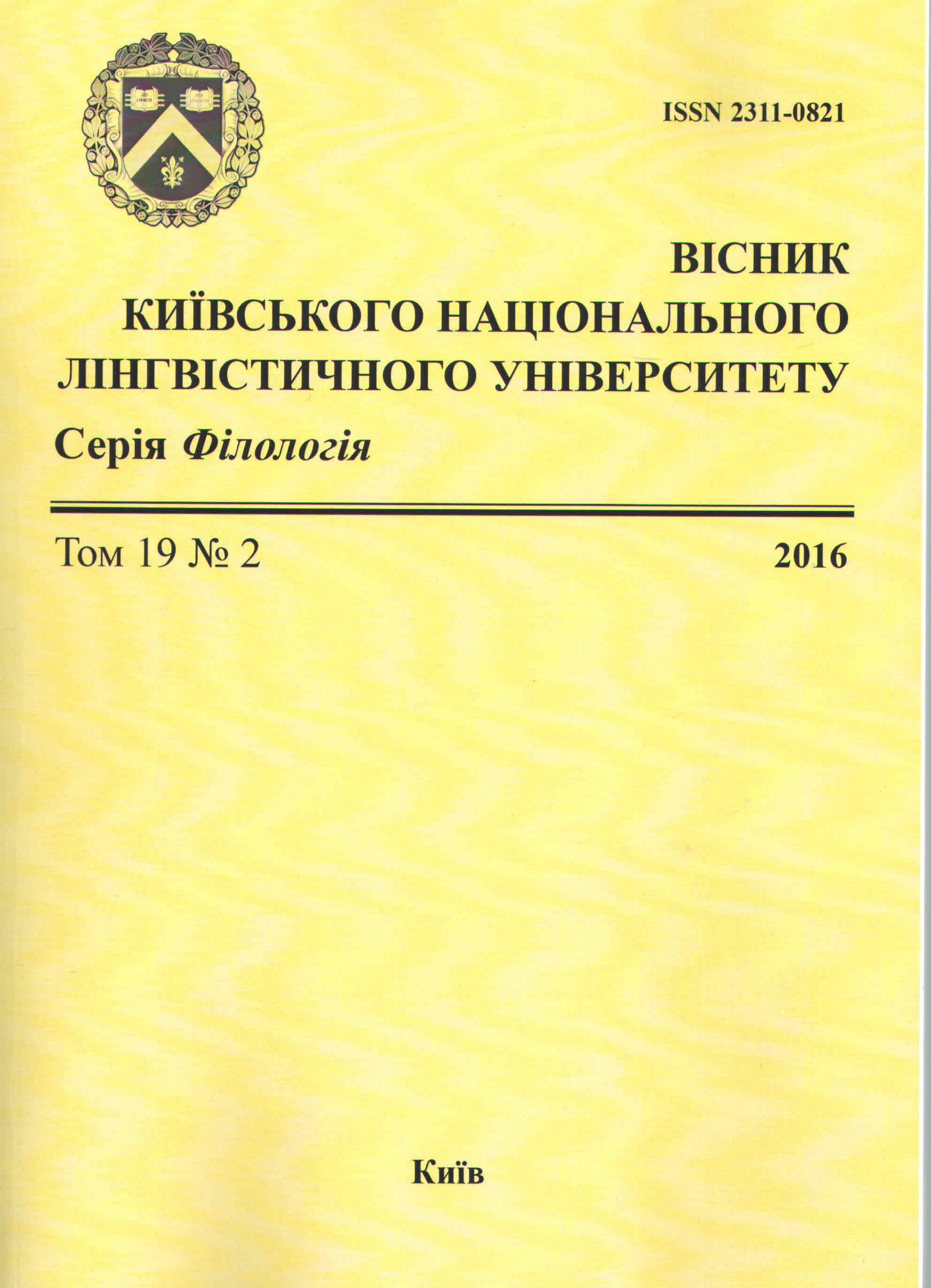ТАЛАНТ І ЙОГО ПРИХИЛЬНИКИ (ХАРАКТЕРИСТИКА СТИМУЛУ ТАЛАНТ ТА ЙОГО КОРЕЛЯТІВ У СХІДНОСЛОВ’ЯНСЬКИХ МОВАХ ЗА РЕЗУЛЬТАТАМИ ПСИХОЛІНГВІСТИЧНОГО ЕКСПЕРИМЕНТУ)
DOI:
https://doi.org/10.32589/2311-0821.2.2016.113743Ключові слова:
образ світу, мовна свідомість, асоціативний експеримент, асоціативне поле, асоціативний гештальт, the world reflection, linguistic consciousness, associative experiment, associative field, associative gestaltАнотація
Етнокультурні дослідження специфіки образу світу носіїв різних мов займають провідне місце в сучасних роботах із психолінгвістики. У контексті зазначеної проблематики
виконано пропоновану статтю. Увагу автора сфокусовано на вивченні мовної свідомості представників східнослов’янських етносів з метою виявлення загальних та специфічних
рис образів світу носіїв кожної культури.
У статті подано результати психолінгвістичного аналізу асоціативних полів слівстимулів ТАЛАНТ/ТАЛАНТ/ТАЛЕНТ,
які репрезентують відповідні фрагменти образів світу українців, росіян та білорусів. За допомогою “асоціативного гештальту” виявлено структуру асоціативних полів стимулів-корелятів, кількість зон у гештальтах, обсяг та якісне наповнення зон. Визначено й охарактеризовано ядро та периферію асоціативних полів у кожній мові. З’ясовано національно-культурну специфіку образів мовної свідомості представників східнослов’янських народів.
Посилання
Этимологический словарь русского языка Макса Фасмера [Электронный ресурс]. – Режим доступа : http://slovno.com.ua/etimologicheskiy_slovar_russkogo_yazyika_maksa_fasmera/
Етимологічний словник української мови : [у 7 т.] / редкол. : О.С. Мельничук [гол. ред.] та ін. – К. : Наук. думка, 1983–. – Т. 5 : Р – Т / уклад. Р.В. Болдирєв та ін. – 2006. – 704 с.
Залевская А.А. Введение в психолингвистику / Александра Александровна Залевская. – М. :
Российск. гос. гуманит. ун-т, 1999. – 382 с.
Залевская А.А. Национально-культурная специфика картины мира и различные подходы к ее исследованию / А.А. Залевская // Языковое сознание и образ мира: сб. ст. / отв. ред. Н.В. Уфимцева. – М. : Сарма, 2000. – С. 39–54.
Кочерган М.П. Основи зіставного мовознавства / Михайло Петрович Кочерган. – К. : Вид. центр “Академія”, 2006. – 424 с.
Словарь философских терминов / науч. ред. В.Г. Кузнецова. – М. : ИНФРА-М, 2005. – 731 с.
Словник української мови : [в 11 т.] / АН УРСР. Ін-т мовознавства ; за ред. І.К. Білодіда. –
К. : Наукова думка, 1970–1980. – Т. 10. – 1979. – 658 с.
Стернин И.А. Контрастивная лингвистика / Иосиф Абрамович Стернин. – Воронеж : Истоки, 2004. – 189 с.
Хамитов Н.В. Философский словарь. Человек и мир / Н.В. Хамитов, С.А. Крылова. – К. : КНТ, Центр учебной литературы, 2006. – 308 с.
##submission.downloads##
Опубліковано
Номер
Розділ
Ліцензія
1. Дослідження, що публікуються у збірнику наукових праць, повинні бути виконані відповідно до чинного законодавства України та етичних норм. Основний обов’язок автора полягає в тому, щоб виконати таке дослідження, яке заслуговує на об’єктивне обговорення науковою спільнотою його значущості.
2. Автори повинні формулювати свої наукові спостереження у такий спосіб, щоб їхні результати могли бути підтверджені іншими вченими, без підробки отриманих висновків або маніпуляції ними.
3. Автори статей несуть відповідальність за зміст статей і за сам факт їх публікації.
4. Автор повинен цитувати ті публікації, які вплинули на сутність роботи, а також ті, які можуть швидко познайомити читача з попередніми роботами, важливими для розуміння цього дослідження. За винятком оглядів, слід мінімізувати цитування робіт, які не мають безпосереднього відношення до змісту дослідження. Автор зобов’язаний провести джерельний пошук, щоб знайти і процитувати оригінальні публікації, тісно пов’язані з цим матеріалом. Необхідно також коректно вказувати на джерела принципово важливих матеріалів, використаних у цій роботі, якщо вони не були отримані самим автором.
5. Автори повинні дотримуватися усіх чинних вимог щодо публікацій рукописів. Неприпустимим є плагіат та його удавання за оригінальну розвідку, а також подання до редакції раніше опублікованої статті. У випадках виявлення плагіату відповідальність несуть автори поданих матеріалів.
6. Експериментальне або теоретичне дослідження може іноді слугувати основою для науково коректної і об’єктивної критики роботи іншого дослідника. Опубліковані статті в окремих випадках можуть містити подібну критику. Персональна суб’єктивна критика не є доречною за жодних обставин.
7. Співавторами статті мають бути ті особи, науковий внесок яких є вагомим у її зміст та які розділяють відповідальність за здобуті результати. Автор, який подає рукопис до друку, відповідає за те, щоб до списку співавторів були включені всі ті й лише ті особи, які відповідають критеріям авторства. У статті, написаної декількома авторами, той з авторів, хто подає до редакції контактні відомості, документи і листується з редакторами, бере на себе відповідальність за згоду інших авторів статті на її публікацію у збірнику.
8. Автори повинні повідомити редактора про будь-який потенційний конфлікт інтересів, на які могла б вплинути публікація результатів, що містяться у рукописі.
9. Автори повинні чітко вказати джерела всієї процитованої інформації, оформити посилання на наукові джерела відповідно до вимог ДСТУ ГОСТ 7.1:2006.
10. Редколегія має право відмовити у публікації статті за умов недотримання зазначених вимог.
11. Автор може висловити побажання не залучати деяких рецензентів до розгляду рукопису. Проте головний редактор може прийняти рішення залучити одного або декількох із цих рецензентів, якщо переконаний, що їх думки є важливими для неупередженого розгляду рукопису. Таке рішення може бути прийняте, наприклад, у тому випадку, коли є серйозні суперечності між цим рукописом і попередньою роботою потенційного рецензента.
12. Запобігання псевдонауковим публікаціям є відповідальністю кожного автора, головного редактора, рецензента, видавця й організації.


